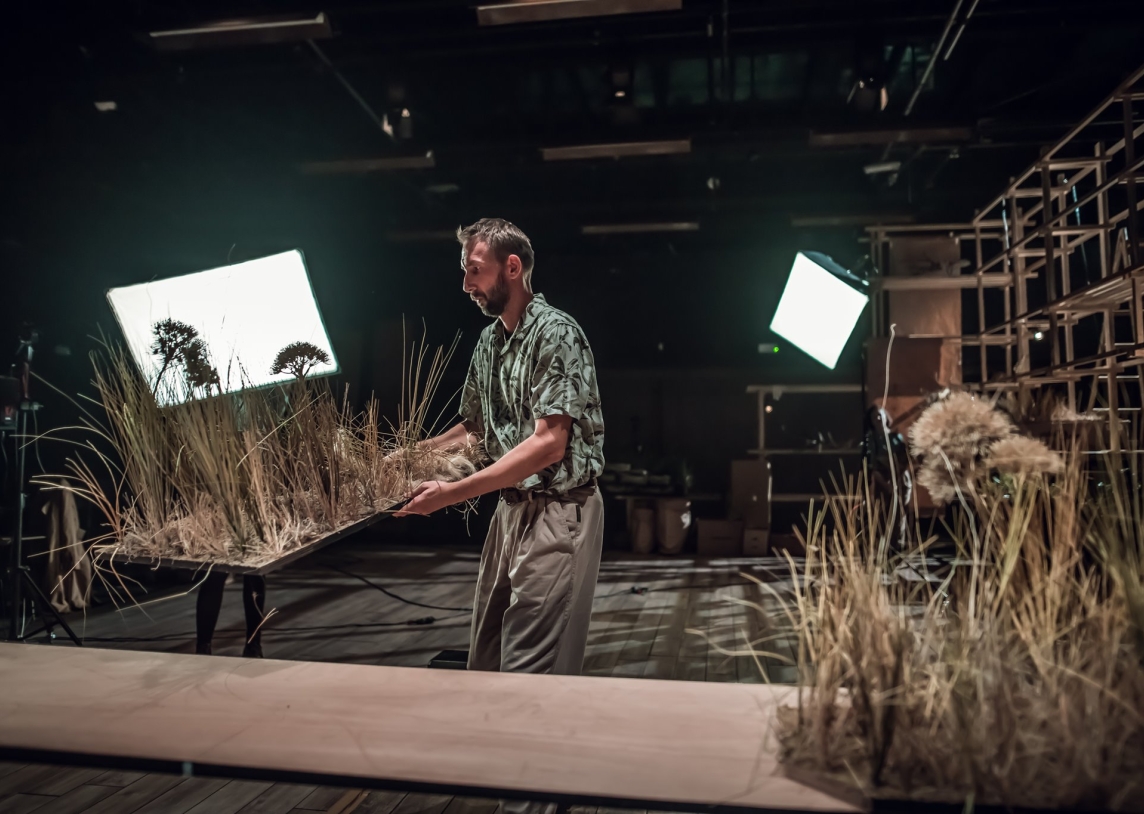- International Platform
- Content
Content
The Six-Armed Life of a Rabbit
Translated by Laima Bezginaitė
The Ljubljana Puppet Theatre’s performance Still Life shares nine ways of preserving life. At the same time this performance in a way becomes a memorial for the humble art of taxidermy. A time has come where circuses do not feature tricks by trained animals in their shows anymore. I believe that soon taxidermy will also fall into oblivion, as we have become infinitely sensitive to the suffering of all the other life forms. On the other hand, Theatrum Anatomicum and new artistic experiments with the human body are almost here, maybe even right behind the corner of the next year. Meanwhile, let’s make a record – in 2020, the Slovenian puppet theatre came up with an inventive idea of dressing skillfully made mechanical puppets with real rabbit furs.
On the stage there is an exhibition table. On this table are stuffed wild rabbits, as well as rabbit dolls, which can be recognized from metal sticks attached to the limbs and from handles used for controlling body parts. Also, there is a massive rack and a desk on the left side of the stage. The scenery reminds of a modern photo studio prepared for a specific photo shoot. Light and shadows are of particular importance here. Even before the actors start controlling the puppets, the stuffed rabbits are slowly brought back to life by light and sound. The viewers are immersed into the primal natural environment of these stuffed animals by recreated nature’s sounds and the subtle changes of light of the environment, without any attempts to hide behind the illusory nature of the stage, by acting deliberately openly, by revealing the technicalities of puppet control, and the mechanisms and means of the birth of a miracle on the stage.
The stage which acts as a playground of an artistic, creative laboratory allows the actors to start dissecting the theme without any delay. From the very first minutes, facts become an important part of the performance’s text. Light is directed to each specific stuffed animal. The facts are announced – where, how, for how much... These naked facts – clean, neutral, and ironic – are laid down next to the stuffed rabbits that are observing us through their glass eyes. The exhibition table is prepared for the next operation – a fragment of natural landscape is installed on it. We can see a mass of sedges, moss, lichen, a fragment of a spruce, and ferns. After light, shadows, and sound are simulated, the three actors take their places beside the table and start controlling the first animal.
Six human arms are needed to reanimate a single rabbit. Four are used for controlling the limbs, while the remaining two help to animate the movements of the back and to move the mechanisms built into the puppet’s head. These move the ears and the mouth. The eyes remain motionless, alert, and glassy. In the first scene from a rabbit’s life, the actors recreate the natural gait of a mother rabbit, returning to the nest to nurse her newborns, her body’s shivers and the micro movements that help to create the wedge of a surreal existence.
All the subsequent scenes demonstrate the man’s skillful ability to imitate nature and to glorify her through creations of his hands. The actors prepare the natural relief of the next scene. They cover the table with material that simulates the unevenness of the ground, which they top with a green imitation of turf, insert plants, and moisten the surface. Into this ideal meadow the second rabbit is released – it slowly hops around, nibbles at grass, stretches to scratch at its fur. Each of these microscenes is ended by gently laying the puppet onto the artificial piece of nature, while the actors respectfully linger over its inanimate body.
The next rabbit is placed in a night scene, where among the tree stumps and tufts of grass it frantically claws against the dirt, trying to dig a hole. The light is minimal, the three actors that control the puppet are almost invisible, but the rabbit’s movements are active and rhymical, the puppeteers’ actions are very harmonious and perfectly synchronized. The final scene features another large rabbit puppet among tufts of grass and massive stones. The actress who is controlling its head stands with her profile to the audience, her face unbelievably focused, calm from the outside, but also very responsive and reflective to every microscopically precisely performed movement of the animal. The rabbit is cleaning its fur and stroking its face; suddenly, a shot sounds, and the body is jerked into the air. It hides. It is alive. After a lengthy period of hiding, it musters its courage to look around. It observes and assesses the surroundings. The rabbit’s eyes are still glassy, but as if alive, filled to the brim with the echo of the shot.
The performance ends with an exposition of stuffed rabbits. Once again, they stand frozen on the exposition table, in this artificial piece of nature. For us it is a moment of observing something that was created based on deep humanist motives of showing compassion to life, of acknowledging the inherent uniqueness and authenticity of all the living creatures. And of admitting the inability to recreate all this.
This publication is written in the context of the project "European Contemporary Puppetry Critical Platform"
This publication is funded by the Lithuanian Council for Culture

